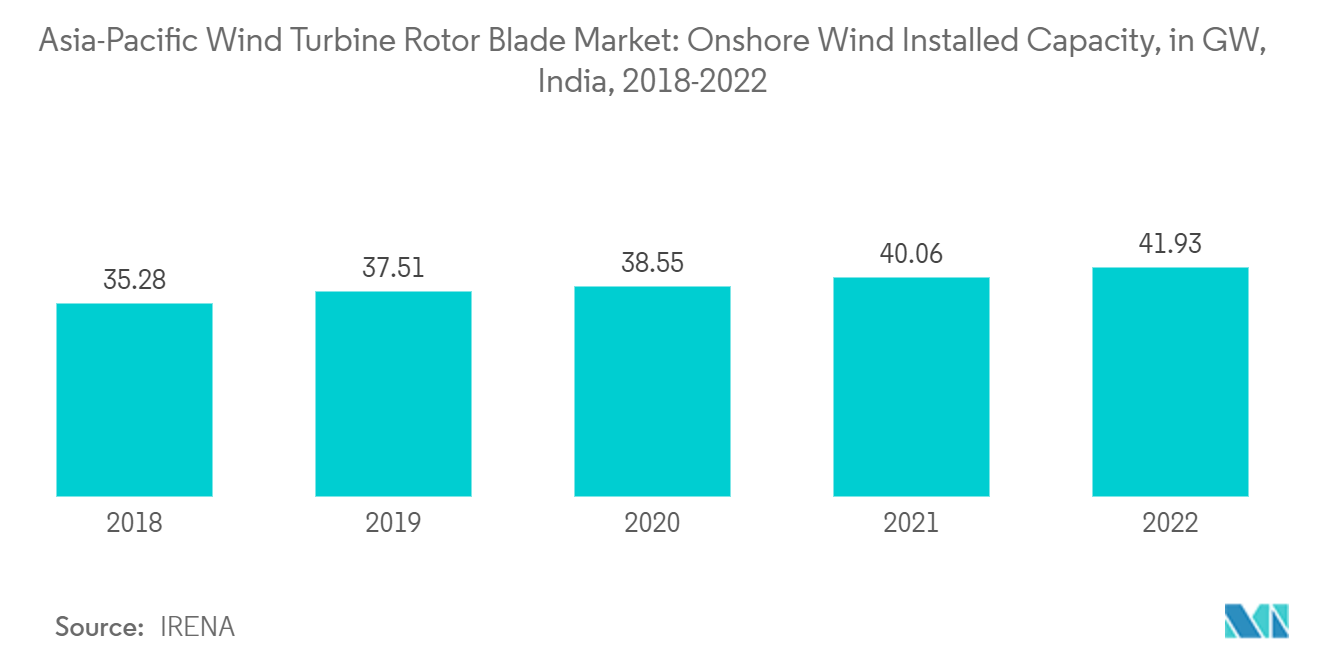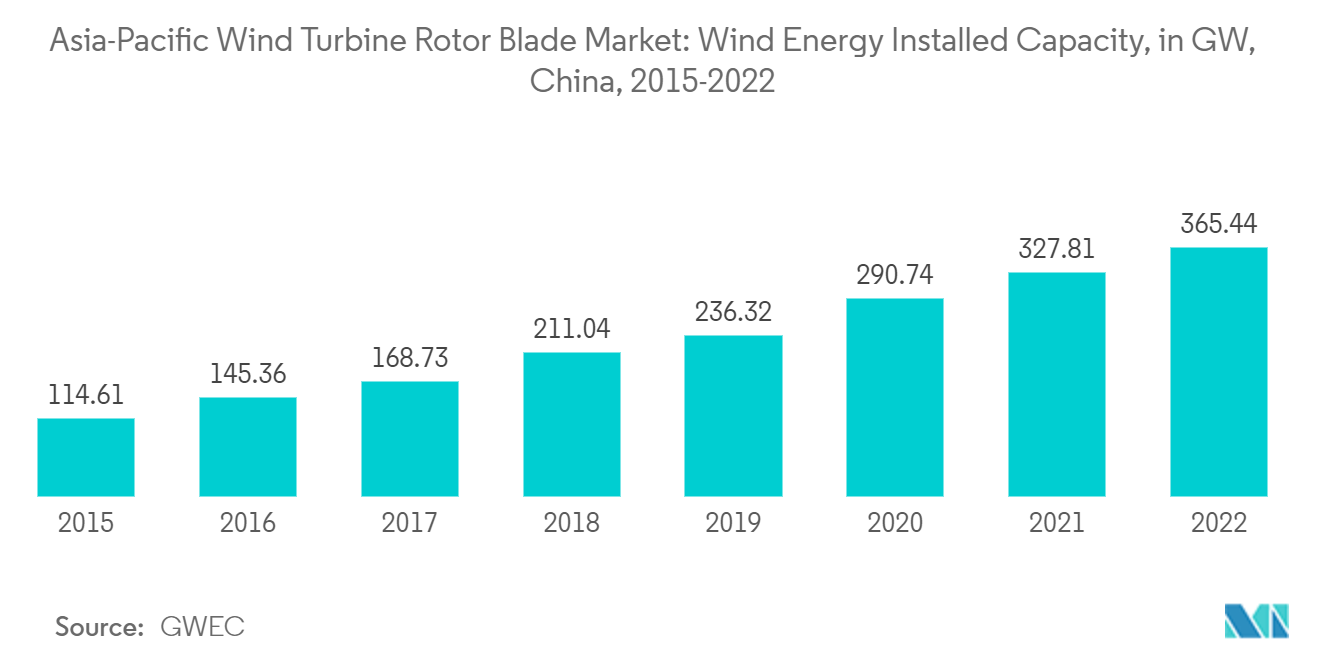Market Trends of Asia Pacific Wind Turbine Rotor Blade Industry
Onshore Segment to Dominate the Market
- The onshore wind energy power generation technology has evolved over the last five years to maximize electricity produced per megawatt capacity installed and to cover more sites with lower wind speeds. Besides this, in recent years, wind turbines have become larger with taller hub heights, broader diameters, and larger wind turbine blades.
- According to the Global Wind Energy Council (GWEC), the Asia-Pacific onshore wind market added 36.97 GW in 2022 and contributed 53.72% of the total global onshore wind installations in 2022.
- The growing investments in several major countries, such as China and India, are expected to drive the market demand during the forecast period. China and India are some of the fastest-growing economies in the world, and hence, they have registered significant growth in domestic power consumption.
- During COP26 in November 2021, the Prime Minister of India announced that India plans to reduce emission intensity by 45% or more by 2030, bringing it to levels below those of 2005, and announced 500 GW of non-fossil fuels energy capacity by 2030; 50% renewables in the energy mix by 2030.
- As of January 2022, non-fossil fuels represent 38.5% of overall power generation capacity. Wind currently accounts for 10.2% of this capacity. As part of its 2030 climate commitments, the Ministry of New and Renewable Energy (MNRE) estimates 140 GW of wind energy capacity is required.
- In October 2022, the NLC India Ltd., a Public Sector Undertaking (PSU) part of the Ministry of Coal, entered into a strategic collaboration agreement with the National Institute of Wind Energy (NIWE), an autonomous Research and Development institution under the Ministry of New and Renewable Energy (MNRE), for the development of onshore wind power projects in India.
- India holds the fourth-largest onshore wind power installed capacity globally as of 2022. These projects are majorly spread in the northern, southern, and western parts of the country. According to IRENA, India's total installed wind capacity was 41.93 GW, witnessing an increase of 4.64% compared to 40.06 GW in 2021.
- Moreover, according to the International Energy Agency, the Levelized cost of energy (LCOE) and global weighted average total CAPEX is likely to decrease from 76.1 USD/MWh and 1730.5 USD/MWh in 2016 to 48.2 USD/MWh and 1396.3 USD/MWh in 2021. In addition, the LCOE and average weighted CAPEX are expected to decrease in the forecast period to 44.6 USD/MWh and 1338.2 USD/MWh, respectively, by 2025.
- The onshore large wind turbine rotor blade market is expected to grow in the forecast period due to declining LCOE and reduced CAPEX, coupled with high energy demand through clean sources.

China to Dominate the Market
- China is the largest energy consumer and renewable energy market globally, and the country is rapidly expanding its renewable energy capacity to satiate its domestic energy demand. As the country has been suffering from air pollution caused primarily by fossil-fuel-fired power plant emissions, it has focused on expanding its renewable energy capacity to meet its growing energy demands while reducing overall emissions.
- As part of its 14th five-year plan (2021-2025), the country aims to supply 33% of national power consumption by 2025 and 18% of non-hydro renewables. The country aims to increase renewable energy generation to 3,300 TWh by 2030.
- In its latest updated Nationally Determined Contributions (NDC), China has committed to reaching peak emissions by 2030 and achieving carbon neutrality as part of its commitments under the Paris Agreement. In terms of energy targets, the country aims to cut C02 emissions per unit of GDP by more than 65% from 2005 levels and increase the total installed wind plus solar capacity to 1,200 GW.
- According to CarbonBrief, based on the rapid growth of the renewable energy industry in the country, it is estimated that China will reach its target of 1,200 GW of wind+solar deployment significantly ahead of its 2030 deadline. Such rapid growth in the installed wind energy capacity is due to the rising demand created due to environmental commitments, and the increasing domestic energy consumption is expected to drive the wind energy market during the forecast period.
- China’s provinces have set up individual targets for renewable energy projects as a part of national targets. The largest targets have been set up by the northwestern provinces of Inner Mongolia and Gansu to leverage the presence of large tracts of uninhabited desert lands. These two provinces plan to add a cumulative 190 GW of wind and solar projects by 2025, in addition to the 74 GW of installed capacity as of May 2022. These provinces are followed by Shaanxi, Hebei, and Shandong, which have planned to install 190 GW of new solar and wind capacity additions during 2021-2025.
- According to GWEC, in 2022, the total wind installed capacity increased by 11.5% compared to the previous year in China. The total wind energy installed capacity accounted for about 365.44 GW.
- Coastal provinces in China have been focused on developing new offshore wind capacity. Guangdong aims to install 18 GW of offshore capacity by 2025, while Fujian, Zhejiang, and Jiangsu aim to install 13.3GW, 6GW, and 9GW of offshore wind power projects by 2025, respectively.
- Shandong aims to add 35 GW of offshore wind power capacity by 2030 while starting the construction of 10 GW of projects and adding 5 GW to the grid by 2025. The island province of Hainan has been permitted by the National Energy Administration (NEA) to build 12.3 GW of offshore wind by 2025.
- Further, in December 2022, Chinese wind turbine manufacturer Mingyang Smart Energy produced the World’s Longest Anti-Typhoon Offshore Wind Turbine Blade for the MySE 16-260 offshore wind turbine, an elevated version of its 16 MW model, announced in 2021 with a 242-meter rotor diameter.
- Thus, the growing investment from state-owned companies and favorable government policies in wind energy generation are expected to drive the growth of the Chinese wind turbine rotor blade market during the forecast period.

